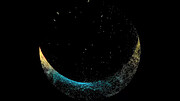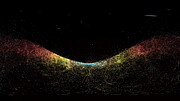A mosaic of images captured using W. M. keck Observatory's keck cosmic web imager showing the filaments of gas that make up the cosmic web. the green dots mark known galaxies the filaments connect to. Credit: C. Martin et al./Caltech/W. M. Keck Observatory
Keck Cosmic Web Imager Offers Best Glimpse Yet of the Filamentous Network That Connects Galaxies
Maunakea, Hawaiʻi Like rivers
feeding oceans, streams of gas nourish galaxies throughout the cosmos.
But these streams, which make up a part of the so-called cosmic web, are
very faint and hard to see. While astronomers have known about the
cosmic web for decades, and even glimpsed the glow of its filaments
around bright cosmic objects called quasars, they have not directly
imaged the extended structure in the darkest portions of space—until
now.
New results from the
Keck Cosmic Web Imager, or KCWI, which was designed by Caltech’s Edward C. Stone Professor of Physics
Christopher Martin
and his team, are the first to show direct light emitted by the largest
and most hidden portion of the cosmic web: the crisscrossing wispy
filaments that stretch across the darkest corners of space between
galaxies. The KCWI instrument is based at the
W. M. Keck Observatory atop Maunakea in Hawaiʻi.
“We chose the name Keck Cosmic Web Imager for our instrument because
we were hoping it would directly detect the cosmic web,” says Martin,
who is also the director of the Caltech Optical Observatories, which
includes Caltech’s portion of Keck Observatory; other Keck Observatory
partners are the University of California and NASA. “I’m very happy it
worked out.”
Galaxies in our universe condense out of swirling clouds of gas. That
gas then further condenses into stars that light up the galaxies,
making them visible to telescopes in a range of wavelengths of light.
Astronomers think that cold, dark filaments in deep space snake their
way to the galaxies, supplying them with gas, which is fuel for making
more stars. In 2015, Martin and his colleagues found “smoking-gun evidence,” as Martin describes it, for this so-called cold-flow model of galaxy
formation: a long filament funneling gas into a large galaxy. For this
work, they used a prototype instrument to KCWI, the Cosmic Web Imager,
which was based at Caltech’s Palomar Observatory.
In that case, the filament was being lit up by a nearby quasar, the
bright nucleus of a young galaxy. But most of the cosmic web lies in the
desolate territory between galaxies and is hard to image.
“Before this latest finding, we saw the filamentary structures under
the equivalent of a lamppost,” says Martin. “Now we can see them without
a lamp.”
The new findings
appear in a paper published in Nature Astronomy on September 28.
This animation reveals a 3-D slice through a network of hydrogen gas filaments that crisscross the spaces between galaxies. The data were collected by the Keck Cosmic Web Imager, or KCWI, which was designed to reveal the structure of this previously hidden component of the universe. The region covered in this observation is about 10.5 billion light-years away. The volume depicted here spans an area of 2.3 by 3.2 million light-years and extends across a depth of 600 million light-years (50 million per segment). Credit: Caltech/R. Hurt (IPAC)
Martin has been driven to reveal the cosmic web in its full glory
ever since he was a graduate student. This detailed imaging of the web,
he says, will provide astronomers with missing information they need to
understand the details of how galaxies form and evolve. It can also help
astronomers map the distribution of dark matter in our universe (dark
matter makes up about 85 percent of all matter in the universe, but
scientists still don’t know what it is made of).
“The cosmic web delineates the architecture of our universe,” he
says. “It’s where most of the normal, or baryonic, matter in our galaxy
resides and directly traces the location of dark matter.”
The Feeble Glow of Filaments
The best way to see the cosmic web directly is to pick up signatures
of its main component, hydrogen gas, using instruments called
spectrometers, which spread light out into a multitude of wavelengths,
also known as a spectrum. Hydrogen gas can be identified within these
spectra via its strongest emission line, called the Lyman alpha line.
Martin and his colleagues designed KCWI to find these faint Lyman alpha
signatures across a two-dimensional (2D) image of the cosmos (hence KCWI
is known as an imaging spectrometer). The instrument’s first
installment covers the “blue” portion of the visible-light spectrum,
spanning wavelength ranges from 350 to 560 nanometers. (The second part
of the instrument, called the
Keck Cosmic Reionization Mapper, or KCRM, which sees the red, or longer-wavelength portion, of the visible spectrum,
was recently installed at Keck Observatory).
KCWI’s precise spectrometers can look for the Lyman alpha signatures
of the cosmic web across a range of wavelengths. Because of the
expansion of the universe, which stretches light to longer wavelengths,
gas that is located farther away from Earth has a redder Lyman alpha
signature. The 2D images captured by KCWI at each wavelength of light
can be stacked together to make a three-dimensional (3D) map of the
emission from the cosmic web. For this observation, KCWI observed a
region of space between 10 and 12 billion light-years away.
“We are basically creating a 3D map of the cosmic web,” Martin
explains. “We take spectra for every point in an image at range of
wavelengths, and the wavelengths translate to distance.”
One challenge in detecting the cosmic web is that its dim light can
be confused with nearby background light that suffuses the skies above
Maunakea, including the glow from the atmosphere, zodiacal light from
the solar system (generated when sunlight scatters off interplanetary
dust), and even our own galaxy’s light.
To solve this problem, Martin came up with a new strategy to subtract this background light from the images of interest.
“We look at two different patches of sky, A and B. The filament
structures will be at distinct distances in the two directions in the
patches, so you can take the background light from image B and subtract
it from A, and vice versa, leaving just the structures. I ran detailed
simulations of this in 2019 to convince myself that this method would
work,” he says.
The result is that astronomers now have “a whole new way to study the universe,” as Martin says.
“With KCRM, the newly deployed red channel of KCWI, we can see even
farther into the past,” says senior instrument scientist Mateusz
Matuszewski. “We are very excited about what this new tool will help us
learn about the more distant filaments and the era when the first stars
and black holes formed.”
Speaking of new ways to view the universe, Martin teamed up with
artist Matt Schumaker to translate data from the cosmic web into music
for a project called “Spiral, supercluster, filament, wall (after
Michael Anderson).” The project celebrates the life of Anderson, who
perished along with his fellow astronauts in the Space Shuttle Columbia
accident in 2003. Martin, who “pretended the filaments were giant violin
strings,” translated the filaments’ masses to frequencies based around
the note middle C. The piece can be heard
here.
The
Nature Astronomy study, titled “
Extensive diffuse Lyman alpha emission correlated with cosmic structure,” was funded by the National Science Foundation and Caltech.
About KCWI
The Keck Cosmic Web Imager (KCWI) is designed to provide visible band, integral field spectroscopy with moderate to high spectral resolution formats and excellent sky-subtraction. The astronomical seeing and large aperture of the telescope enables studies of the connection between galaxies and the gas in their dark matter halos, stellar relics, star clusters, and lensed galaxies. KCWI covers the blue side of the visible spectrum; the instrument also features the Keck Cosmic Reionization Mapper (KCRM), extending KCWI’s coverage to the red side of the visible spectrum. The combination of KCWI-blue and KCRM provides simultaneous high-efficiency spectral coverage across the entire visible spectrum. Support for KCWI was provided by the National Science Foundation, Heising-Simons Foundation, and Mt. Cuba Astronomical Foundation. Support for KCRM was provided by the National Science Foundation and Mt. Cuba Astronomical Foundation.
About W. M. Keck Observatory
The W. M. Keck Observatory telescopes are among the most scientifically productive on Earth. The two 10-meter optical/infrared telescopes atop Maunakea on the Island of Hawaii feature a suite of advanced instruments including imagers, multi-object spectrographs, high-resolution spectrographs, integral-field spectrometers, and world-leading laser guide star adaptive optics systems. Some of the data presented herein were obtained at Keck Observatory, which is a private 501(c) 3 non-profit organization operated as a scientific partnership among the California Institute of Technology, the University of California, and the National Aeronautics and Space Administration. The Observatory was made possible by the generous financial support of the W. M. Keck Foundation. The authors wish to recognize and acknowledge the very significant cultural role and reverence that the summit of Maunakea has always had within the Native Hawaiian community. We are most fortunate to have the opportunity to conduct observations from this mountain..































